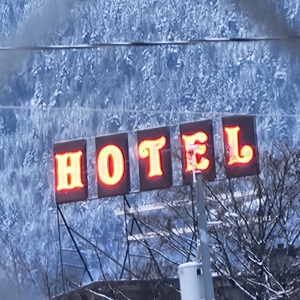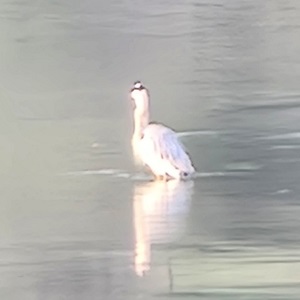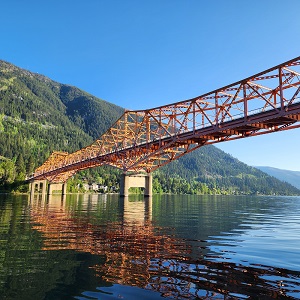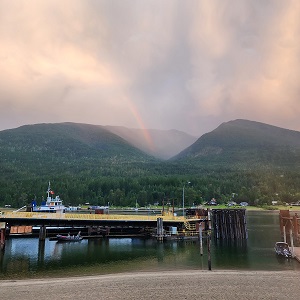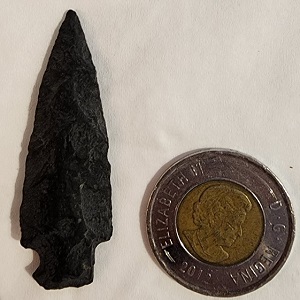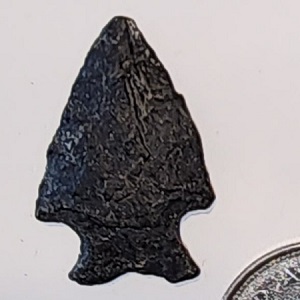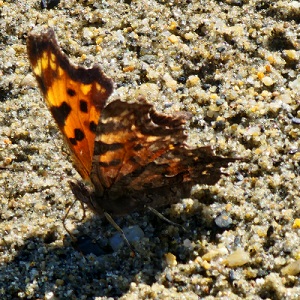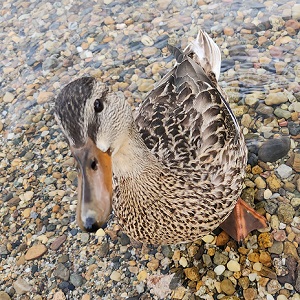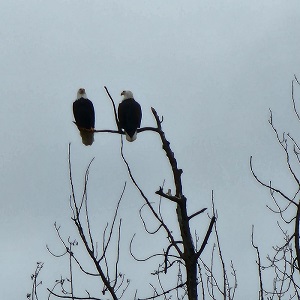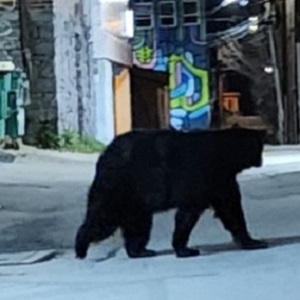It's an instinct, this treasure hunting.
And the garage sale season having passed, a short season this year, hampered by finances and transportation, the instinct seeks its outlet.
I take the children to a riverside park in the neighborhood to look for stones for their rock tumbler.
And sorting through the gravels, the abundant pebbles, we're surprised to find an old indian bead.
 Small, perhaps an inch and a half, with a perfectly bored hole straight through it.
Small, perhaps an inch and a half, with a perfectly bored hole straight through it.
And it triggers the instinct.
There are no buried treasures in Alberta, well, very few anyways. There's the Lost Lemon Mine, if you credit the legend, and undoubtedly more than a few mason jars filled with farmers life savings buried under fence posts, but there's none of the classic treasure hunting raw materials, gems, gold, sunken ships.
But there is history, in it's way a sort of treasure.
Before I go too much further I should note that it's illegal to look for archeological artifacts in Alberta. If you see or spot an archeological artifact you are supposed to call the provincial museum and leave the site undisturbed. All artifacts are property of the state.
Now, on paper this is ideal. It speaks to our highest and noblest selves, our shared history is our shared property to be preserved for future generations.
But like many laws that at first glance look good on examination we can discover that it lacks both teeth and foresight. We think nothing of building entire neighborhoods (In Calgary, think Bowness, Crescent Heights, Mount Royal, Hawkwood, and many, many more) over Native sites. We build highways over them, farmers rearrange the stones on their field, taking apart medicine wheels, teepee rings, burial grounds are buried beneath parks, golf courses and basements. The vast majority - over 99% of the paleo and archeological history of Calgary - lies buried under suburbs, or has been churned by bulldozers and ploughs destroying any contextual value the sites may have provided.
We turn a blind eye, or excuse it with "You can't stop progress".
Which is true, but laws that allow and encourage laypeople to collect, document and report finds and artifacts would would save much of this.
No government could ever afford to staff a province or even a country the size of Alberta with the number of archeologists we would need just to keep abreast of progress. Of the expanding highways, cities, suburbs, oil sands.
It is, upon examination, an idiotic law that is in its way far worse than having no laws at all. The kind of law that is intended to reassure the people that "we're protecting our history" when in fact we are systematically destroying it. Destroying it through ignorance, through "Let the experts handle it", through progress and neglect. Presumably countries that don't have similar laws have no valued history, you only need to look at countries like the US or Great Britain to see how their lack of competent legislation has destroyed their history....
I digress, but I will return to this theme again and again.
So we discover the bead, and search through the gravels but find nothing more, some fossils, other stones that might look good polished, but that is all.
But the seed is sown.
We return the next week, it's a nice outing this park, plenty of people on a hot summer day, many lazily riding the creek in their dinghies, others wading in the creek. And we walk the gravels looking for signs of early Alberta occupation. It's an education for the children, a fine way to pass a hot summer afternoon (although I sense the dissent in the boy, he's older and has other thoughts, would prefer to be playing his video games. But my daughter is helpful, a little too helpful as I'll discover....).
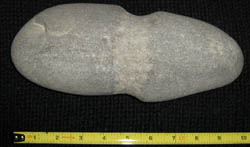 And we are perhaps half an hour on the sandbar we find a hammer. A very large and obviously handworked hammer. Pecking visible completely around one side, 1/2 around the other. A formidable tool. There are some stray marks at the end (just visible in this picture), otherwise an impressive piece. This on a gravel bar that sees daily traffic in the heart of Calgary.
And we are perhaps half an hour on the sandbar we find a hammer. A very large and obviously handworked hammer. Pecking visible completely around one side, 1/2 around the other. A formidable tool. There are some stray marks at the end (just visible in this picture), otherwise an impressive piece. This on a gravel bar that sees daily traffic in the heart of Calgary.
This cements the instinct. We look over the sandbar, there are many signs of human life, litter, dog tracks, footprints, the remains of large bonfires, which lead you to wonder if they were recent or ancient. But there's no telliing without digging, probably no telling at all. This stone was on the surface, not in any ways buried, so it's unlikely that much would be revealed through digging that you couldn't infer from looking.
Once a good campsite, always a good campsite. That's an easy rule when looking for artifacts. Those prime areas to us, if the land hasn't changed, were prime areas to the indigenous peoples. The fire rings built by revellers on the river often use the same stones, and often the very same location, as have been used for hundreds and thousands of years. But it's remarkable that this stone has lain here, unrecognized and unrecovered. There must be, on a busy day, 50 to a hundred people up and down this beach. But none have noticed it. Or reported it. Or perhaps it's been reported, and just deemed not worth picking up.
 The children are vaguely enthused, the daughter bringing me every rock that she can find, claiming it to be an artifact and showing me how it was used. I don't want to discourage her. Some may well have been, but over time it becomes impossible to tell. These stones have laid here for hundreds, in cases thousands of years. Over time marks have become eroded, chipped away through tumbling in the river, stones will have been buried in floods, others exposed. The course of the river has changed again and again.
The children are vaguely enthused, the daughter bringing me every rock that she can find, claiming it to be an artifact and showing me how it was used. I don't want to discourage her. Some may well have been, but over time it becomes impossible to tell. These stones have laid here for hundreds, in cases thousands of years. Over time marks have become eroded, chipped away through tumbling in the river, stones will have been buried in floods, others exposed. The course of the river has changed again and again.
When the children are with me we have to limit our visits, half an hour is about all the treasure hunting they can stand. We find numerous stones with erosion holes in them, which I take to show the children the difference between an eroded and a drilled hole. The bead, it's obvious, it has a polish, a feel to it that the other stones don't, the hole is smaller, tighter. But there is always the possibility that many or some of these stones had uses as well, after all, why would you go to the work of drilling a hole through a stone when nature had done it for you? Fishing weights, pendants, buttons....
The rocks are continually moving down the river. Depending where they sit on the bank, their weight relative to their surface area, their position relative to other rocks, they are tumbled. There is the seasonal spring flooding, the dry crust that forms over the rocks near the water is proof of this. And the floods that happen every 5 years, every ten years, the hundred year flood plain that the neighborhoods of Cliff Bungalow and Mission sit upon (although, as the climate changes, so will the flooding).
And knowing this you should be able to derive a formula, whereby X * T * A/W = D
X being the position of the rock relative to the river, T being Time, A being Area divided by W - Weight of the stone, the formula would assist to determine the distance any artifact had travelled from the moment of its manufacture...
This is ideal, the average, but it's a speculative exercise, the average applies only to groups and never to individuals.
****
I return alone, in the evening, to walk different areas.
It's the end of summer, August, the light is changing, the sun is down by 9:00. I explore the trails and eventually step off of them, ten yards off the main path and were it not for the houses on the hills just visible in the distance I might be a thousand miles from Calgary.
That's all it takes. Step off the trail, ford a creek and you've travelled further, explored more than 99% of the people that visit this area. It's a rule for life. There are huge gravel beds here exposed, the old courses of the river, I've explored a bit and found places where people had dug up small holes, perhaps a yard wide, looters looking for artifacts probably, there can be no other explanations for digging here, there are no pirates treasures, no truffles, gold, crystals or gems, they're "Amateur Archeologists", boffins who perhaps found an arrowhead and thought enough to dig the ground looking for more. From the holes you can tell they were amateurs, spade marks, irregular, abandoned after a few clods of dirt unearthed, I kick through them but there's nothing.
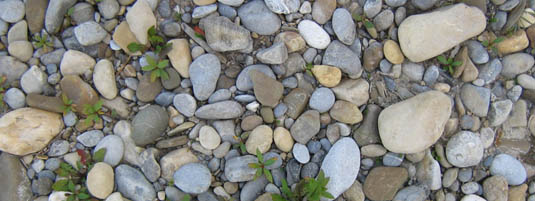
I walk and search, scan the gravels.
An arrowhead. I'd like to find an arrowhead. I've watched the you tube videos of people looking for arrowheads in Missouri, other places throughout the US, some are obviously staged, the director having placed the arrowhead and "re-enacted" his finding of it, some appear to be real, none of them have to contend with the sheer number of stones that exist in the Bow Valley Drainage. Calgary is a city built upon gravel. Look at it long enough and you will see artifacts everywhere. Nature has confounded you by cleverly eroding a thousand axe-heads, a million hammerstones, ten million arrowheads and scrapers and tomahawks, and jumbling them all together here. In the videos they find the arrowheads easily, they stand out against the mud, worn from the riverbanks, here I've found nothing.
Arrowheads, though, are easy to identify, everyone knows an arrowhead, and so they get picked up, even here, where 99% of people never walk.....
It's peaceful.
You walk, alone with your thoughts, scanning the gravels. Picking up rocks, looking for chips, signs of usage, discarding, walking. The sun hangs low, warm, mosquitos buzz you, walking the gravel....
In the river the stones glitter like gems where the currents have washed the rocks clean. The ripples deform every stone into an arrowhead, an axe head, a spear, until you reach in and pull them out. In other spots there are only the fuzzy, algae covered outlines of rocks. Here you will go blind simply by looking at the sheer number of rocks. There are hundreds of acres of stones, and walking, scanning, the river that once ran through here has sorted the gravels, there are banks of smaller pebbles, rows of larger stones, heaps of boulders. And you walk and you scan.
******
The public library filled my head with stories of children who had discovered caves, Indian graves and campsites, gold mines and Hopi treasures, secret tunnels under castles that led to dungeons and jewels, children who were taken by their parents to deserted islands then left alone to find the pirates treasure.
I despised my childhood in Saskatchewan, there were no treasures to be found, no dinosaurs, no pirates, no gold or gems or mountains to climb or caves to explore and the joys of walking a prairie where every horizon was bare for miles into the distance were lost upon me. But then one summer, one summer only, I discovered the river.
Perhaps I was 10 or 12, they had dredged the river up and the muck lay in piles along the banks, my summer free of parents (both working), I was left to my own devices. It was a different world. Now, the world is safer, but the news is more terrifying, and to leave your child unattended for even a moment is to invite criminal charges. Children must be supervised at all times. But I was free in that time when all children were free in the summers and somehow or another I survived, found my way to the river to walk along and explore. There had been an article in the paper about a child who had found a live hand grenade in the river, a discarded souvenier of the war, and I was envious of his fame.
A fossil tooth, jutting from a pile of mud. Sifting the sand by the river I found tiny fossilized bones, teeth, jaws, skulls, all turned into a clear agate, I collected some, left others, over time they were lost. And what at the time I thought was a human legbone, still think was a human legbone, I had seen pictures in books, it was not a cowbone or deers, too narrow and with a finer knuckle on each end, but in the end I doubted myself, threw it back into the river, I was under warning for my morbid imagination and didn't want to be further chastised for it. I kept the teeth, there could be no scoffing at those.
Michael Ibach, or perhaps it was Chris Segal, in grade 3 came to school, pocket full of Indian Arrowheads, he was selling them off for a dime each. His brother and a friend had found a spot up by the lake where they filled buckets with them. And I purchased one, wished that I could have found that secret place by the lake, held onto it until I was moving at 22 and slept in a car with only my dearest possessions, the rest all donated to the Salvation Army. The souveniers of childhood.
*****
Mark West was a friend of the family, an old farmer who had collections of rocks he had picked up on his land. A giant agate spearhead he showed us once, bigger than his hand, he had spotted it from the cab of his tractor, gotten down, brought it in. It was a marvel of times past we could only dimly imagine. My great grandfather, himself a marvel of times past, telling me of the early days on the farm, down by the lake ploughing he had unearthed human bones, taking them into the RCMP he had been told that if he didn't want trouble with land claims he should return and rebury them, which he did, careful not to plough that area again. And the local museum, small with it's collection of native artifacts and costumes, the centerpiece of which was a large fieldstone with a face dimly inscribed, found on a farm, estimated to be 10, 000 years old.
*****
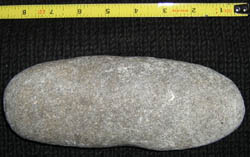 The sun is low, I've wandered here for a couple of hours, I've forgotten how late the day was getting, how late the summer is. The shadows from the hills are filling the ravine. Straightening up I look for the landmarks to follow home, and I spot it. An oddly shaped rock, like a potatoe, I prise it from the cobbles and take it to the creek to rinse off.
The sun is low, I've wandered here for a couple of hours, I've forgotten how late the day was getting, how late the summer is. The shadows from the hills are filling the ravine. Straightening up I look for the landmarks to follow home, and I spot it. An oddly shaped rock, like a potatoe, I prise it from the cobbles and take it to the creek to rinse off.
It fits the hand perfectly, a narrow indentation for the fingers. 1000, 10, 000 years in a riverbed have worn away most of the marks people made. But still....it's rough, not river polished but different, on the end of the stone are numerous pecking marks. You hold it, feel the weight, another hammer.
*****
The Alberta Provincial Museum and the Glenbow together have tens of thousands of native artifacts, arrowheads and relics. The vast majority of them are filed away in cellars and archives, never to see the light of day. Graduate students of the various university programs may, on occasion, have interest in or access to them, but they are strictly off limits for the general public. We accept the history of the province as narrated to us by those we've appointed its custodians.
With most of this, there is nothing new to be learned. An arrowhead here, a hammer there, these things are the objects, but they need to be placed in context. The context is the excavation, the site on which they were found, the materials of which they were made, the strata in the ground. Once this has been extracted and measured the artifacts are filed, now no more than curiosities. History is dead.
If you go to Milk River, Writings on Stone has none of the artifacts recovered there on display. The site was excavated, in part, materials taken, shipped to the museum, dissected, analyzed and pigeon holed. If you'd like to see some of the actual artifacts recovered then you should plan a trip north.
It's history out of context.
For children, history is a place in the land of far away field trips and quiet museums, dimly lit displays of waxen dummies reenacting boring scenes from our past. They don't realize that history isn't a long time ago in a galaxy far, far away, it's here, beneath their feet, often there simply for the looking. But looking is only part. Handle the tools, the hammers are stone, hand crafted, they've endured thousands of years, there's no chance of them being broken. Know where it was found, on the street where now is your house, imagine how this area looked even just a hundred years ago, imagine how this tool was used. Try to imagine a world without game boys and DS's and XBOX, where dinner was uncertain and you camped out every single night of your life.
But we don't. History is the far away place of field trips and boring homework. It is the waxen dummies and crummy illustrations in textbooks. It is always over there, back when, under glass, off limits and inaccessable. They are living through history but can't understand.
*****
 There are abundant fossils here. No gems or gold, no dinosaur bones even, but plenty of shells and corals preserved in limestone. The occasional fossil bison tooth, Camels, Bears, Sloths, Sabre Tooth Tigers. The pre-ice age megafauna. Twice in Calgary people have dug out their basements to discover the tusks of Wooly Mammoths.
There are abundant fossils here. No gems or gold, no dinosaur bones even, but plenty of shells and corals preserved in limestone. The occasional fossil bison tooth, Camels, Bears, Sloths, Sabre Tooth Tigers. The pre-ice age megafauna. Twice in Calgary people have dug out their basements to discover the tusks of Wooly Mammoths.
Glaciation covered much of this up, mixed up the bones, it's unlikely you would ever find a complete skeleton near here. But if you sort through enough gravel there will be teeth, maybe bones.
We find lots of the corals, washed down from the mountains in Kananaskis. An odd piece of turtella, not at all shaped by the river. That's the problem with glaciation, it shovels rocks hundreds and thousands of miles from where they should be normally found. The Okotoks Erratic, lifted and dropped here by a glacier. If there were people here before glaciation, which some archeologists suspect, the slender evidence of their presence will be almost impossible to detect.
Fossils in Alberta have similar laws protecting them. You are allowed to surface collect dinosaur bones (Not in parks, such as Dinosaur Provincial Park). You are not allowed to dig for fossils. Any significant finds must be reported to the museum. Fossils remain the property of the Alberta Government, you are only the caretaker. You are not allowed to sell or trade the fossils, they are considered a part of Alberta's Heritage.
Note that all these rules are waived if you're a member of a large commercial organization. Prospecting for Oil and Gas, Coal, which are natural fossils and derivitives, are exempt. Mining diamonds, gold, or gravel naturally exempts your company. In fact almost anything we do, if we can justify it in the name of progress, such as building another Wal-Mart or digging a bigger swimming pool in your back yard,will exempt you from these rules. But as an individual with an interest in natural history, be aware of the laws. The small company that mines ammonites in Southern Alberta does so by special charter from the government of Alberta. Their high prices undoubtedly reflect the pain of dealing with the beaurocracy.
Another fine example of the inanity of blanket "feel good - we're protecting our heritage" laws. 99.9% of fossils in Alberta will never be recovered. Not because of the protection of government, but because the province is large and sparsely populated, fossils by their nature are fragile and when eroded from the bedrock which has protected them often only last a year or two on the surface before breaking down into silt and dust. Erosion in the badlands happens in many places at rates at up to an inch a year. And many of the fossils offer us nothing new. Report the find of a duckbilled dinosaur to the people at the Tyrrell Museum and they will almost certainly brush you off. They have plenty of duckbilled dinosaurs, so abundant were they that any of the staff can wander the badlands for an hour or two and come back with a fair sized chunk. But better to let it erode away into dust than have an unauthorized hobbiest digging up pieces, possibly (albeit unlikely) selling it on the black market, or even selling off something exciting or important....
Hence, in what must be one of the more ironic turns, all of the rock shops in the Drumheller region sell imported fossils, while often only yards from their back door the local dinosaurs crumble into dust.
There are better models. In the US again, which provides many of the fossil shops in Canada with their specimens, quality specimens are collected by amateurs using most and often all of the techniques of trained paleontologists, because the quality of the specimen, the documentation that goes into it's recovery, are all reflected in the higher prices they are able to charge. A rare example of the free market, at work.
(Top left - rock filled with shells - Turtella?. Middle: 2 photos of fossil corals, bottom left: fossilized bison tooth)
*****
On the way back I spy a frog upon the trail. Small, no bigger than the tip of your thumb. Memories of childhood, I haven't seen a frog in the wild for 30 years. Snakes, maybe one or 2. Never a salamander, not since I caught them at 8 or 9. Not because I don't walk these places anymore, I still do, but because they've disappeared. Our impact is bigger, more far reaching, than we have imagined, and most of these common memories of childhood have disappeared.
As a child I'd play at the school across from our house, faced with rough Manitoba limestones you could find in it the imprint of sea snakes, corals, shells, a rare fish, in the cavities between it's rib grew fine red crystals which we imagined were dried blood.
*****
The daughter and I, we explore another area. I've been through here before, if the other areas, with their 50-100 people a day, are remote, then this is the opposite. A gravel bar on the main river, not a mile from downtown. People drifting by in their inflatable boats, the fire rescue patrolling in their speedboat, on the bar people have set up lawnchairs to catch the few remaining rays of summer.
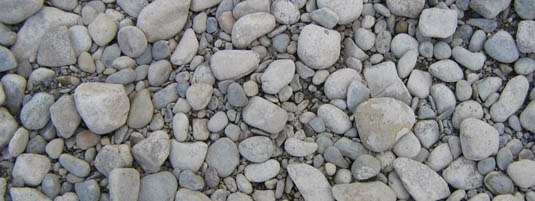
It's hopeless, but it's outdoors, a nice walk, a fine way to pass the day. There is everywhere the debris of the city, used condoms, cigarette butts, beer cans, this beach has been walked a million times. Still we look.
The cobbles are dirty, dried algae forms a uniform grey crust over them all, we will only be able to spot things by shape...
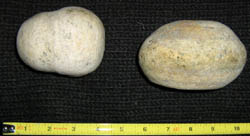 Within 5 minutes we've found 2 stones. 1, a hammer headed stone tomahawk, the other, a foot away, an apparently worked stone disc, flattened on the top and bottom with curiously bevelled sides, perhaps used for grinding, it's purpose unclear.
Within 5 minutes we've found 2 stones. 1, a hammer headed stone tomahawk, the other, a foot away, an apparently worked stone disc, flattened on the top and bottom with curiously bevelled sides, perhaps used for grinding, it's purpose unclear.
Underfoot, in the middle of the city, unrecognized, undiscovered, for hundreds, perhaps thousands of years. It's hard to believe that any province with a sincere and competent department of Archeology would have ignored this, but as always we ignore the obvious, presume it's already been done...
And the river provides no context. On the river there is nothing to dig, things are where you find them, the things that might have helped to place them in time have long since been washed away.
This sets off a mania, we comb the gravel looking for more artifacts, there are undoubtedly more, but they are sometimes impossible to distinguish. A few hatchet shapes, we wash them in the river, when first wetted there is the momentary hope that perhaps they are real, the flash of bright emerald green, Jade traded from BC? but scrub some more and the green washes off, algae, mere simulcrae shaped by erosion. Perhaps we should collect them, cut some saplings and make our own tools...
Looking in the water, the occasional flashes of brighter stones, the ripples deforming them into arrowheads, reaching in, pulling out, banded sandstones glisten like tigers eyes, rosy quartz pebbles like gems, granite like carnelian, but nothing.
There are thousands of tools here, the tools used to make the tools, any of the broken flakes from boulders that could have been hide scrapers, there are slight pecking marks on dozens of stones - natural?, we stay an hour, walk perhaps 30 yards of the river and call it a day.
These trips, they train the children, they train the eye. You learn to see again, to see deeper, to see into things. It gets easier, although still the dull uniformity of grey shapes can blind you. And sometimes it's unconscious, the reaching for a rock that on any other day would be an ordinary cobble, and we track and photograph only our successes, the countless things a more experienced eye would spot still elude us. The marvels of our history, so close at hand and foot.
And though the finding is important, the spiritual fuel to continue, it's more about the searching. As Robert Service so eloquently put it:
"Yet it isn't the gold that I'm wanting
So much as just finding the gold."
We have a few short weeks left in the summer, if life doesn't get in the way (as so often it does) we'll return, explore near and further and see what we can discover.
It's an instinct.
Further reading?
Try:
http://www.daysknob.com/Topper_A.htm - on Zoomorphic rocks, in which the "archeologist" not only discovers any number of scrapers, arrowheads, etc, that look just like rocks but then proves that not only are they artifacts, but they've been shaped to look like animals! (Caution: Personally, I don't see it. Maybe it's just the pictures. But if you follow the authors reasoning then every trip is guaranteed to be a success!)
http://www.snopes.com/humor/letters/smithsonian.asp - yes, it's a hoax but it's amusing nonetheless.
OK. The first two links really necessitate the inclusion of this link:
http://www.badarchaeology.net/ - sadly the authors have allowed it to get out of date.
http://www.idl.idaho.gov/bureau/Minerals/gem_guide/gg_index.htm - Rockhounding in Idaho. Because basically it's forbidden in Alberta.
http://forum.treasurenet.com/index.php?action=featuredposts - Metal detecting forum, with some interesting user submitted finds.

